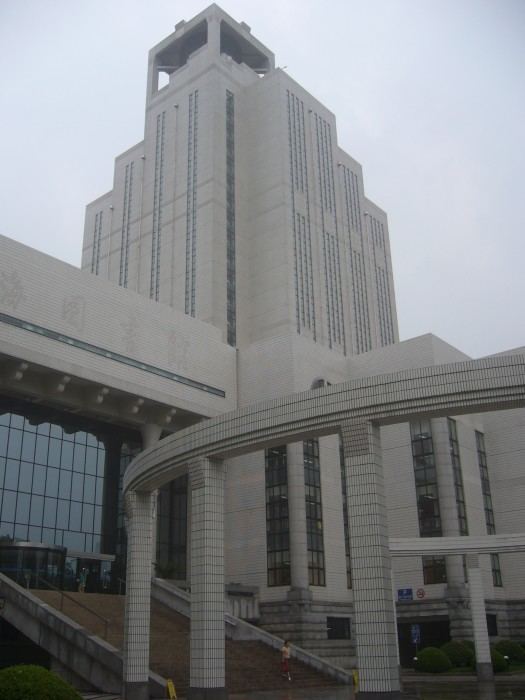Established 1847 Branches n/a Population served members of the public | Location Shanghai, China Circulation n/a Phone +86 21 6445 5555 | |
 | ||
Size 1.7 million ancient Chinese books
50.95 million items Address 1555号 Huaihai Middle Rd, Xuhui Qu, Shanghai Shi, China, 200031 Hours Closed now Friday8:30AM–5:20PMSaturday8:30AM–5:20PMSunday8:30AM–5:20PMMondayClosedTuesday8:30AM–5:20PMWednesday(Qingming Festival)8:30AM–5:20PMHours might differThursday8:30AM–5:20PMSuggest an edit Similar Shanghai Museum, Shanghai French Concession, Shanghai Science and Tech, Shanghai Art Museum, Shanghai Grand Theatre | ||
Shanghai library
Shanghai Library (Simplified Chinese: 上海图书馆; Pinyin:Shànghǎi túshūguǎn) is the second largest library in China after the National Library of China in Beijing. It is located in Shanghai, China. At 24 stories and 348 feet (106 m) tall, it is the tallest library in the world, as well as one of the largest. The building has a tower that looks like a giant lighthouse.
Contents
- Shanghai library
- Early History The Xujiahui Zikawei Library
- Mergers
- Ancient books protection
- Library in the modern era
- Internet access
- Location
- References
Shanghai library
Early History: The Xujiahui (Zikawei) Library
The Bibliotheca Zi-Ka-Wei is the first modern library to have been established in Shanghai. It was established in 1847.
Mergers
In 1925, Shanghai East Library, the first library run by Chinese, was opened. In 1950, the Shanghai Cultural Heritage Managing Committee launched a campaign to collect books and after about a year, the collection grew to more than 200,000 volumes. Many scholars and celebrities contributed and some of them made large donations. The committee also started to buy books from abroad. After the mission schools and scientific establishments had been taken over by the Chinese government, the last foreign Jesuits left Xujiahui in 1951. The Xujiahui Library, along with other libraries formerly run by foreign groups, was placed under the control of the Shanghai Municipal Library, which had been established on July 22, 1952. This was the first large municipal public library in Shanghai. The library had a collection of more than 700,000 volumes. Shanghai Library merged with the Shanghai Municipal Library of Science and Technology, the Shanghai Municipal Library of Historical Documents, and the Shanghai Newspaper Library in October 1958. The Xujiahui Library (Bibliotheca Zikawei), which reopened in 1977, also became a branch of the Shanghai Library. It was the second largest comprehensive public library in China, in terms of collection, services, and professional expertise.
Ancient books protection
Shanghai library has compiled 130 volumes of ancient books (including books about 180 thousand copies), 160 thousand (of which 2 thousand copiess),the Ming and Qing Dynasties in modern letters 118 thousand. A large increase in the collection, fully illustrated by the care and support of all sectors of society, the Shanghai library for the collection and preservation of traditional cultural heritage of great importance.
Library in the modern era
Shanghai Library merged with the Institute of Scientific and Technological Information of Shanghai (ISTIS) in October 1995. It became the first ever library in China that combines public library services with SciTech and industry information research functions. It is operated with a high efficient book transportation system type Telelift to handle the huge volume of books per day.
Today, it is the largest public library in China and one of the ten largest libraries in the world. It was opened to the public on December 20, 1996. It covers 3.1 hectares of land, with a floor space of 83,000 square meters.
Internet access
On the ground floor there is a room with internet access for 4 yuan per hour. The opening hours are everyday from 9 to 20:30.
Location
The Library is located at 1557 Huaihai Zhong Lu, Xuhui District of Shanghai. (Address for locating the Shanghai Library Simplified Chinese: 上海市淮海中路1557号,近复兴中路)
